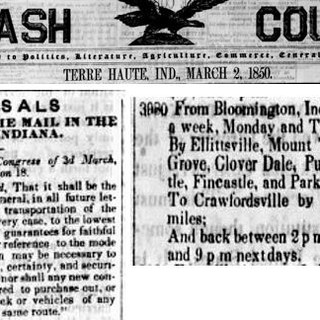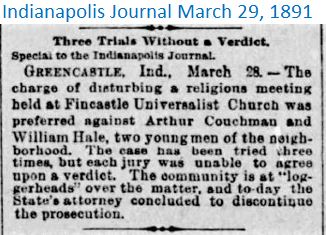Fincastle
- Larry Tippin, County Historian
- Jul 29, 2019
- 3 min read
Fincastle is a small community ten miles north of Greencastle. It was platted May 17, 1839, about ten years after Blakesburg which was a little over a mile to the west. The 1864 business directory for Fincastle lists the dry goods and grocery store of Zaccheus Grider and also resident farmer Jacob Cord. Also noted in 1864 was the Christian Church on the north end of town, a school and residences of B. Harris, C. W. Twigg, J. Buntruant, J. Apple and M. Devaul. One of the prominent early families of the area was the Bridges family.
Charles Boles Bridges came from Montgomery County, Kentucky, near Mt. Sterling, to Indiana in September of 1834, settling first near Parkersburg. He then bought the James Secrest farm of 160 acres near Blakesburg. A biographical sketch of Charles Boles Bridges can be found on page 723 of Weik’s 1910 History of Putnam County. He had five sons and four daughters, the oldest being Robert who built the large brick home about a mile and a half north of Fincastle. Other large wood frame homes nearby were also built by the Bridge’s and are still in use today. Charles and Robert Bridges operated stores in both Fincastle and Cairo which was located northwest of Fincastle.
By 1852 Bridges was in the store business in Fincastle and owned over 4,000 acres of land. About this time, he heard of a cook stove they were using in Ohio, so he sent there and bought one - - the first in the neighborhood - - which proved to be a great advantage over the fireplace, and for which he paid $37.00.
Just south of Fincastle was the old tavern road, which connected the communities in the early days. Various sources indicate the road that went east and west just south of Fincastle was one of the main roads in northern Putnam County and the primary route one would take from Danville to Rockville. It followed the south side of Ramp Creek as it went west of Fincastle to Blakesburg. East of Fincastle it crossed Ramp Creek eighteen different times as it went to Bainbridge. Apparently, it was easier to stay near the waterways rather than blazing trails in the dense forest of the day whenever possible. And crossing the waterways was not a real problem, thanks to the tall wheels of the wagons and stagecoaches in use at that time. The tavern roads were also used to transport mail from one post office to the next, often by horseback.
The earliest post offices in the area were at nearby Blakesburg, starting in 1828 and Swanksville in 1829, which were the second and third post offices in the county, respectively. Blakesburg was west of Fincastle and Swanksville northwest. The Fincastle post office would start almost twenty years later, after Blakesburg and Swanksville were no longer the thriving early communities they once were. Postmasters at Fincastle were: David Fosher, October 21, 1847; Reuben W. Moss, March 6, 1850; Charles B. Bridges, June 11, 1853; Samuel J. Ritchey, June 23, 1855; William B. Cunningham, April 3, 1857. The post office was discontinued November 20, 1858, but reinstated February 15, 1877 when Robert L. Bridges was appointed postmaster. Postmasters at Fincastle then were: Thomas L. Grider, April 5, 1881; Jesse B. Fosher, February 16, 1883; Zaccheus Grider, June 18, 1884; James B. Shannon, July 9, 1885; Calvin Harris, January 24, 1889; Thomas L. Grider, January 17, 1890; Ora G. Edwards, May 4, 1893; James F. Edwards, May 25, 1895; Henry C. Fosher, October 26, 1895; Thomas L. Grider, September 13, 1897. The post office was discontinued on January 14, 1905.
Early sources also indicate that the main north-south road in the area went north out of Blakesburg, through Cairo, then Swanksville and on to Parkersburg on the way to Crawfordsville and Lafayette. By the 1840’s, a road went north and south through Fincastle, which would become State Road 43 in 1927, then U. S. Highway 231 in 1955.
In 1871, the impressive brick church at Fincastle was dedicated by the Universalists and of which church Charles and Robert Bridges were staunch supporters. Charles Boles Bridges give the church a Needham & Sons silver-toned organ which cost $440.00. Robert Bridges and his descendants were long-time members of this church. There was also a Christian Church in Fincastle, a smaller wood frame structure just east of the Universalist Church. Both buildings are still standing and are private residences now.
Photos courtesy of Sara Bridges and Lora Scott.
Be sure to check out Malcolm Romine’s book on Blakesburg and Fincastle at the Putnam County Museum.








































































Comments